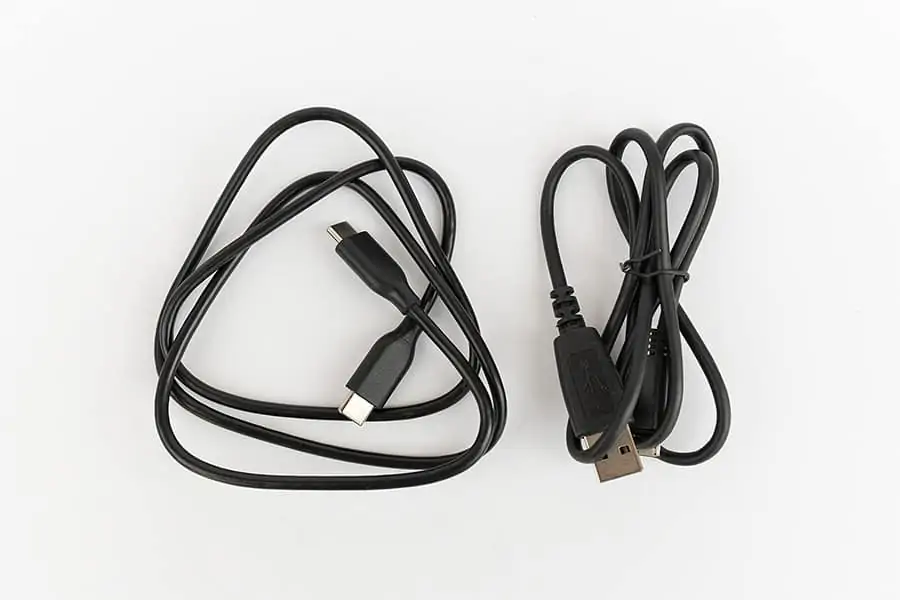DIY Video Studio is supported by its readers. Please assume links on this site are affiliate links or ads, and that I get commissions for purchases made through these links. As an Amazon Associate, I earn from qualifying purchases. Thank you if you use any of the links.
If you own a Canon DSLR or mirrorless camera it may or may not be supplied with a USB cable, or USB interface cable as Canon prefers to call it. These cables can be extremely useful for several reasons, providing your model is capable.
Please note that your camera’s ability to exploit a USB connection is unrelated to whether a USB cable has been supplied with the camera. Nor is the price of your camera an indicator of whether it comes with a USB interface cable. For instance, the EOS R and R5 both come with a USB cable, but the EOS R6 does not. I find this an odd situation since the R6 sits between the R and R5 in both its capabilities and price.
Here are some reasons why you might need a USB cable for your Canon camera.
- Transfer of images to a computer
- Tethering your camera for remote shooting
- Using your camera as a webcam
- Charing the battery inside the camera.
Not all Canon cameras are capable of all the above uses. But if your camera has a USB socket, then you should be able to do at least one of the above.
You will find that buying the Canon original cable is more expensive than a generic but just as capable USB cable. For that reason, the following table will tell you what the Canon USB interface cable is for your Canon camera, whether the camera ships with the cable, and what the cable is if you want to buy one on Amazon or eBay.
| Camera Model | Canon Suggested USB Interface Cable | What is the cable really? | Bundled with camera |
| EOS-1D X Mark III | IFC-100U (to USB C) | USB 3.1 Type C to Type C cable | Yes |
| EOS R | IFC-100U (to USB C) | USB 3.1 Type C to Type C cable | Yes |
| EOS Ra | IFC-100U (to USB C) | USB 3.1 Type C to Type C cable | Yes |
| EOS R5 | IFC-100U (to USB C) | USB 3.1 Type C to Type C cable | Yes |
| EOS R6 | IFC-100U (to USB C) | USB 3.1 Type C to Type C cable | No |
| PowerShot G5 X Mark II | IFC-100U (to USB C) | USB 3.1 Type C to Type C cable | No |
| PowerShot G7 X Mark III | IFC-100U (to USB C) | USB 3.1 Type C to Type C cable | No |
| EOS M6 Mark II | IFC-100U (to USB C) | USB 3.1 Type C to Type C cable | No |
| EOS RP | IFC-100U (to USB C) | USB 3.1 Type C to Type C cable | No |
| EOS 70D | IFC-130U | USB 3.0 Type A to Micro B | Yes |
| EOS Rebel T6i | IFC-130U | USB 3.0 Type A to Micro B | Yes |
| EOS Rebel T6 | IFC-130U | USB 3.0 Type A to Micro B | Yes |
| EOS 1200D/Rebel T5 | IFC-130U | USB 3.0 Type A to Micro B | Yes |
| EOS 600D/Rebel T3i | IFC-130U | USB 3.0 Type A to Micro B | Yes |
| EOS 1100D/Rebel T3 | IFC-130U | USB 3.0 Type A to Micro B | Yes |
| EOS-1D X Mark II | IFC-150U II | USB 2.0 Type A to mini Type B | Yes |
| EOS 5DS R | IFC-150U II | USB 2.0 Type A to mini Type B | Yes |
| EOS 5DS | IFC-150U II | USB 2.0 Type A to mini Type B | Yes |
| EOS 5D Mark IV | IFC-150U II | USB 2.0 Type A to mini Type B | Yes |
| EOS 7D Mark II | IFC-150U II | USB 2.0 Type A to mini Type B | Yes |
| EOS 1D X | IFC-200U/500U | USB 2.0 Type A to mini Type B | Yes |
| EOS 1D C | IFC-200U/500U | USB 2.0 Type A to mini Type B | Yes |
| EOS 5D Mark III | IFC-200U/500U | USB 2.0 Type A to mini Type B | Yes |
| EOS 7D | IFC-200U/500U | USB 2.0 Type A to mini Type B | Yes |
| EOS 60D | IFC-200U/500U | USB 2.0 Type A to mini Type B | Yes |
| EOS 100D/Rebel SL1 | IFC-200U/500U | USB 2.0 Type A to mini Type B | Yes |
| EOS 6D | IFC-200U/500U | USB 2.0 Type A to mini Type B | Yes |
| EOS 6D Mark II | IFC-400PCU | USB 2.0 Type A to Mini USB Type B cable | No |
| EOS 80D | IFC-400PCU | USB 2.0 Type A to Mini USB Type B cable | No |
| EOS 77D | IFC-400PCU | USB 2.0 Type A to Mini USB Type B cable | No |
| EOS 700D/Rebel T5i | IFC-400PCU | USB 2.0 Type A to Mini USB Type B cable | No |
| EOS 760D/Rebel T6s | IFC-400PCU | USB 2.0 Type A to Mini USB Type B cable | Yes |
| EOS 750D/Rebel T6i | IFC-400PCU | USB 2.0 Type A to Mini USB Type B cable | Yes |
| EOS 850D/Rebel T8i | IFC-400PCU | USB 2.0 Type A to Mini USB Type B cable | No |
| EOS 800D/Rebel T7i | IFC-400PCU | USB 2.0 Type A to Mini USB Type B cable | No |
| EOS 2000D/Rebel T7 | IFC-400PCU | USB 2.0 Type A to Mini USB Type B cable | No |
| EOS 1300D/Rebel T6 | IFC-400PCU | USB 2.0 Type A to Mini USB Type B cable | Yes |
| EOS 4000D/Rebel T100 | IFC-400PCU | USB 2.0 Type A to Mini USB Type B cable | No |
| EOS 200D/Rebel SL2 | IFC-400PCU | USB 2.0 Type A to Mini USB Type B cable | No |
| EOS 90D | IFC-600PCU | USB 2.0 Type A to Micro USB Type B cable | No |
| EOS 250D/Rebel SL3 | IFC-600PCU | USB 2.0 Type A to Micro USB Type B cable | No |
| EOS M50 | IFC-600PCU | USB 2.0 Type-A to Micro USB Type B cable | No |
| EOS M50 MkII | IFC-600PCU | USB 2.0 Type-A to Micro USB Type B cable | No |
| EOS M200 | IFC-600PCU | USB 2.0 Type A to Micro USB Type B cable | No |
| PowerShot SX70 HS | IFC-600PCU | USB 2.0 Type A to Micro USB Type B cable | No |
Tosh Lubek runs an audio and video production business in the UK and has been using the Canon EOS R since it was released in the Autumn of 2018 and the Canon EOS R6 in 2020. He has used both cameras to shoot TV commercials broadcast on Sky TV, promotional business videos, videos of events and functions, and YouTube creator content. He has also won several international awards for his advertising and promotional work. You can meet him by visiting his “video booth” at HashTag Business Events across the country.
Recent Posts
You're Using the Canon RF 50mm f/1.8 WRONG! Here’s How to Fix It
If you’ve recently picked up the Canon RF 50mm f/1.8 STM—affectionately known as the Nifty Fifty—you might be confused by that strange switch on the side of the lens. It doesn’t say AF/MF...
Recently, I shot several customer testimonial videos in 4K for a client when the overheating warning on my Canon EOS R6 appeared. In fact, it appeared three times in five sessions during the day of...


